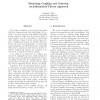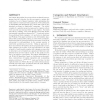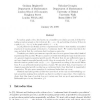478 search results - page 69 / 96 » Structural Properties of Twin-Free Graphs |
WWW
2008
ACM
14 years 10 months ago
2008
ACM
The World Wide Web Consortium's RDF standard primarily consists of (subject,property,object) triples that specify the value that a given subject has for a given property. How...
IJON
2007
13 years 9 months ago
2007
Recent progress in chips–neuron interface suggests real biological neurons as long-term alternatives to silicon transistors. The first step ning such computing systems is to bu...
METRICS
1999
IEEE
14 years 2 months ago
1999
IEEE
The design of software is often depicted by graphs that show components and their relationships. For example, a structure chart shows the calling relationships among components. O...
STOC
2005
ACM
14 years 10 months ago
2005
ACM
The Write-All problem for an asynchronous shared-memory system has the objective for the processes to update the contents of a set of shared registers, while minimizing the mber o...
RSA
2010
13 years 8 months ago
2010
A random graph order, also known as a transitive percolation process, is defined by taking a random graph on the vertex set {0, . . . , n − 1}, and putting i below j if there i...



